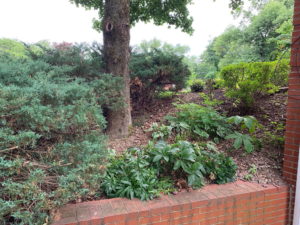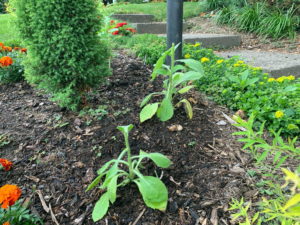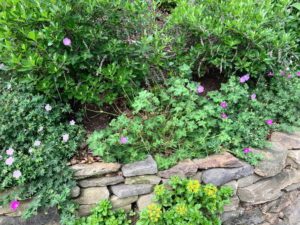Cracking the Deer Plant-Monitoring Network
July 12th, 2022
I’ve long suspected that deer have some sort of sophisticated, yard-monitoring network that lets them take maximum advantage of the plants that gardeners set out.

How did deer pick out hostas from behind a juniper planting, above a three-foot brick wall, and hidden between bleeding hearts and hellebores?
Now I’m sure.
There’s just too much efficiency going on to assume that simple-minded deer happen to wander by and find certain target plants for dinner almost as soon as they’re in the ground.
I think the truth might involve satellites and a scent-driven radar system.
Four episodes in one night nailed it down for me.
One was the six-pack of ‘Denver Daisy’ rudbeckias that I planted in two different spots of my front yard – one of them within five feet of my front bay window (not a spot where you’d think a deer would want to go).
Rudbeckia isn’t a species deer particularly like. Yet three of my new ‘Denver Daisies’ didn’t even make it until the next morning. A neighborhood deer – probably a low-ranking one in the local squadron due to the risky window-side location – devoured the ready-to-open flower buds and stems in the cover of darkness.

These ‘Denver Daisy’ rudbeckias didn’t even make it unscathed through 12 hours in the garden.
The fact that the deer didn’t eat all six tells me that he/she wasn’t very fond of the plants. My hunch is that he/she was assigned to send me a “we’re-in-charge-here” message, but he/she couldn’t quite stomach the full assignment.
You could argue this was happenstance, that deer were passing by and were astute enough to pick out these newbies from the hundreds of other plants in my front yard (all ones low on the deer-preference scale and ones that haven’t already been eaten in the past three years).
But I’ve seen and heard so many reports of instant devouring that I think a more logical explanation is that higher-ranking deer back at headquarters are monitoring our planting activities, most likely using satellites.
This also shows an elaborate communications network in that deer can be dispatched to multiple locations in the same night to send immediate messages to gardeners.
Less suspicious gardeners might write this off as deer just trying to eat, but I give them more credit. I think it’s part of an organized effort to convince us invasive, house-building humans to go back to where we came from and return the land to the way it was.
That hasn’t worked so far, but their efforts have convinced most everyone in my neighborhood to plant little more than ornamental grasses, boxwoods, and barberries.
One neighbor woman who’s been here since the 1970s told me she’s wasted at least $20,000 over the years in deer-eaten landscaping. She didn’t move, but she gave up on planting.
The irony is that if humans had gone onto her property and destroyed that much landscaping, they’d be in jail on criminal charges.
My recent episode No. 2 involved the overnight decapitation of hundreds of Little Quick Fire hydrangea flower buds that were just about to open.
The deer timed this to perfection – let the plants flourish right down to the moment of peakness, then dash it all to inflict maximum grief.
How they knew that was prime time either took some careful monitoring or some skillful horticultural knowledge.
It also took physical ability since these hydrangeas are located on a fairly steep bank atop a three-foot retaining wall.
Even more impressive, though, was Episode No. 3, which involved a small patch of hostas – one of deerdom’s top food choices.
Read George’s PennLive.com post on the 10 plants deer like best… and what to plant instead
The only place I attempted to plant them was off the front left corner of my house, in a shady, sloped bed wedged between a three-foot-tall dense planting of junipers (which deer don’t like and can’t see behind) and another three-foot-tall retaining wall.
To protect the hostas even more, I hid them between a bleeding heart (another plant deer almost never eat) and a band of helleborus (which are toxic to mammals when eaten).
I suspect the hosta patch must have shown up on some sort of deer radar built to detect scent. That has to be the case because there’s no way any deer nose could’ve sorted through the juniper, bleeding heart, and helleborus scents to determine that a few hostas were in the middle.
That same plant-detection equipment must be behind Episode No. 4, too.

The Azure Rush geranium is the one in the middle without any flowers.
Along a stone wall next to my driveway, I planted four different kinds of hardy geraniums. Three of them were old, ordinary ones that I transplanted from elsewhere on the property while I was dejungling 10 years’ worth of neglected weeds. The other was a new, superb, and hard-to-find variety called Azure Rush that I’ve found to be not only a better performer than the geranium standard-bearer Rozanne but one of the best and longest-blooming perennials of any kind.
The deer munched only one of the four geranium plants. Want to guess which one?
Why would a deer do that? Or more to the point, how could a deer do that?
Is Azure Rush significantly tastier to deer than other geraniums? Does it have some kind of chemical signature that deer’s scent-radar system picks up? Or was this a selective hit job carefully monitored and planned by horticulturally keen deer and designed to send the maximum discouraging message?
While I’m asking questions, if deer are innocently just trying to survive, why don’t they fill up on grass or cheapo plants that bounce back quickly or any number of nutritious weeds that are growing prosperously all around the neighborhood?
And why do they let alone some supposedly “deer-resistant” plants for years, only to gnaw them pitilessly to the ground on one random night?
Just chance? I don’t think so. These furry eating machines are smarter than we think.
See George’s post on ways to counteract deer, including a list of “deer-resistant” plants
Read George’s post on deer plant-eating behavior







